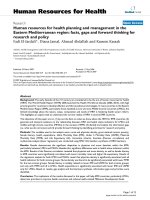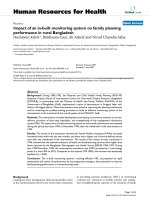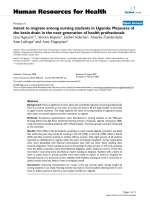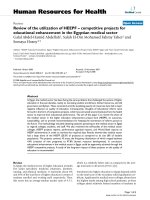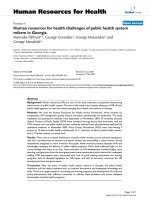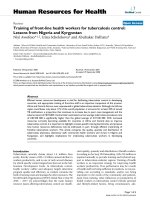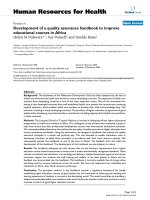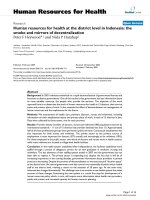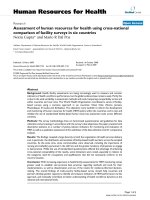báo cáo sinh học:" Mobility of primary health care workers in China" pdf
Bạn đang xem bản rút gọn của tài liệu. Xem và tải ngay bản đầy đủ của tài liệu tại đây (284.49 KB, 5 trang )
BioMed Central
Page 1 of 5
(page number not for citation purposes)
Human Resources for Health
Open Access
Research
Mobility of primary health care workers in China
Qingyue Meng*
1
, Jing Yuan
1
, Limei Jing
1
and Junhua Zhang
2
Address:
1
Center for Health Management and Policy, Shandong University, Jinan, Shandong, PR China and
2
Health Human Resources
Development Center, Ministry of Health, Beijing, PR China
Email: Qingyue Meng* - ; Jing Yuan - ; Limei Jing - ;
Junhua Zhang -
* Corresponding author
Abstract
Background: Rural township health centres and urban community health centres play a crucial
role in the delivery of primary health care in China. Over the past two-and-a-half decades, these
health institutions have not been as well developed as high-level hospitals. The limited availability
and low qualifications of human resources in health are among the main challenges facing lower-
level health facilities. This paper aims to analyse the mobility of health workers in township and
community health centres.
Methods: Data used in this paper come from a nationwide survey of health facilities in 2006. Ten
provinces in different locations and of varying levels of economic development were selected. From
these provinces, 119 rural township health centres and 89 urban community health centres were
selected to participate in a questionnaire survey. Thirty key informants were selected from these
health facilities to be interviewed.
Results: In 2005, 8.1% and 8.9% of health workers left township and community health centres,
respectively. The health workers in rural township health centres had three to 13 years of work
experience and typically had received a formal medical education. The majority of the mobile health
workers moved to higher-level health facilities; very few moved to other rural township health
centres. The rates of workers leaving township and community health centres increased between
2000 and 2005, with the main reasons for leaving being low salaries, limited opportunities for
professional development and poor living conditions.
Conclusion: In China, primary health workers in township health centres and community health
centres move to higher-level facilities due to low salaries, limited opportunities for promotion and
poor living conditions. The government already has policies in place to counteract this migration,
but it must step up enforcement if rural township health centres and urban community centres are
to retain health professionals and recruit qualified health workers.
Background
China's health care system features a three-tiered system
of health providers. In rural areas, village clinics, town-
ship health centres (THCs) and county hospitals are the
major health care providers. In urban areas, community
health centres (CHCs), district hospitals and municipal
and provincial hospitals are the major providers. In this
system, THCs and CHCs link the lower and upper levels
Published: 17 March 2009
Human Resources for Health 2009, 7:24 doi:10.1186/1478-4491-7-24
Received: 20 August 2008
Accepted: 17 March 2009
This article is available from: />© 2009 Meng et al; licensee BioMed Central Ltd.
This is an Open Access article distributed under the terms of the Creative Commons Attribution License ( />),
which permits unrestricted use, distribution, and reproduction in any medium, provided the original work is properly cited.
Human Resources for Health 2009, 7:24 />Page 2 of 5
(page number not for citation purposes)
of health providers and take a lead role in providing both
curative and preventive care to local communities. In
2007, China had nearly 40 000 rural THCs with 860 000
health workers and 3200 urban CHCs with 106 100
health workers [1].
The operation of rural THCs has been challenged over the
past two-and-a-half decades since economic reform began
in China. Compared with upper-level health providers,
THCs are at a disadvantage in terms of mobilizing
resources for their development in a market-oriented
health care system. Upper-level hospitals absorb the
majority of qualified health professionals and high tech-
nologies. People with high incomes prefer to seek care
from upper-level health providers [2].
Because user fees are the major source of financing for
THCs, a decrease in health care utilization results in finan-
cial difficulties. In 2006, only 6.5% of total health expend-
iture was allocated to THCs, while health workers in THCs
accounted for 20% of all health workers in China [3].
Decreased health care utilization and financial troubles
weakened the ability of THCs to recruit and retain quali-
fied health workers [4]. The urban community health care
system was rebuilt at the end of the 1990s. Even though
the number of CHCs has increased rapidly over the past
decade, the quality of health care provided by CHCs is a
concern [5]. A lack of both qualified health workers and
government financial support are among the main rea-
sons behind this low quality of care.
China's central government has clarified its goal of estab-
lishing a universal health care system [6]. One of the strat-
egies for achieving this goal is to strengthen the primary
health care system, focusing especially on THCs and
CHCs. Human resources in THCs and CHCs would be the
key factor in determining their performance. There have
been few studies on the mobilization of primary health
care workers in China, with the exception of a few papers
looking at mobilization in a single hospital [7,8]. The pur-
pose of this paper is to analyse the mobilization of pri-
mary health workers in China using nationwide survey
data.
Methods
The data used in this study come from a nationwide facil-
ity-based survey conducted in 2006. Ten provinces were
selected according to their location and level of economic
development. In each of the provinces, six rural counties
and four cities were selected. In each of the counties, two
THCs were selected, while in each of the cities, three CHCs
were selected. A total of 119 rural THCs and 89 urban
CHCs were selected for a questionnaire survey. From these
facilities, 30 heads of the THCs and CHCs were selected
for key-informant interviews.
Investigators came from Shandong University and the
Health Human Resources development Center, Ministry
of Health. Indicators in the facility-based questionnaire
included total number of health workers, number of
health workers who had left the facility, characteristics of
health workers who left the facility (length of work expe-
rience and educational background) and the institution to
which the health workers moved. The questionnaire was
completed by personnel officers at the selected THCs and
CHCs with instructions from the investigators.
Question guidelines were used in the key-informant inter-
views. Questions for the review included why some health
professionals would leave for new institutions and how
health professionals can be retained by THCs and CHCs.
The interviews were conducted by the investigators in the
interviewee's workplace.
Results
Number, experience and education of primary health
workers who move
In 2005, an average of two health workers per THC and
2.2 health workers per CHC left their working institu-
tions, excluding retirements. In the same year, average
total health workers numbered 24.7 and 24.6 in THCs
and CHCs, respectively. Health workers who moved to
other institutions accounted for 8.1% and 8.9% of the
total health workers in THCs and CHCs.
The health workers who left THCs for other institutions
had work experience ranging from three to 13 years. The
work experience of health workers who left CHCs was
somewhat shorter, ranging from one to six years.
In THCs, 29% of total health workers had received a three-
to five-year formal medical education in colleges or uni-
versities. The majority of health workers had not received
any higher-level medical education. Of the two health
workers who left the THCs in 2005, one had received for-
mal medical education. In CHCs, 73.2% of health work-
ers had received formal medical education. Of the 2.2
health workers who left each CHC, an average of 1.3 had
received high medical education.
Proportion of approaches for leaving
There are two ways in which a health worker can move
from his or her current institution to other institutions.
The "normal" way is that the move is agreed upon by the
current institution. The other is resignation, implying that
the institution does not agree but the health worker insists
on leaving regardless. Health institutions usually rely on
the latter approach in an attempt to retain the workers.
Table 1 shows the proportions of health workers who left
their institutions between 2001 and 2005. Resignations
Human Resources for Health 2009, 7:24 />Page 3 of 5
(page number not for citation purposes)
increased by 6.4% and 10% in THCs and CHCs, respec-
tively, from 2001 to 2005.
Distribution of health workers who moved
More than 50% of the health workers went to higher-level
health institutions after they left the THCs and CHCs
(Table 2 and Table 3). These higher-level health facilities
were usually county hospitals in rural areas and district or
municipal hospitals in urban areas. The proportion of
health workers moving to higher-level health facilities
decreased from 2001 to 2005, with high proportions of
health workers leaving CHCs for non-health facilities in
2001 and 2002. A very small proportion of health workers
left for another health facility of the same level as the one
they left.
Reasons for leaving THCs and CHCs
Salary, opportunities for professional development and
living conditions were the most frequently cited reasons
for moving. The following are key messages from inter-
viewees.
"Income is lower in THCs than in higher level hospi-
tals. Higher level hospitals can offer bonuses for their
health workers besides salaries. We cannot, because
our ability to generate revenues is limited. As head of
this THC, my concern is that some qualified health
professionals within the THC may want to leave
because of low income. One good and experienced
physician left our THC last year mainly due to
income" (the head of a THC in Zongyang County of
Anhui Province).
"Health workers, especially new graduates from medi-
cal universities, feel that there are limited opportuni-
ties for medical practice here than at higher-level
hospitals. In addition, there is a lack of adequate
financing to support health workers to attend training
programmes outside the THCs. Some health workers
try to leave for higher-level health facilities that have
more opportunities for their professional develop-
ment" (the head of a THC in Rongshui County of
Guangxi Province).
"It is hard for us to recruit graduates of medical univer-
sities. The main reason for this is that they realize that
there are fewer opportunities in CHCs than in upper-
level health facilities for professional promotion and
development" (the head of a CHC from Hangzhou
Municipal City of Zhejiang Province).
Table 1: Outflow of health workers from THCs and CHCs (%)
Year THCs CHCs
Normal flow Resignation Other reasons Normal flow Resignation Other reasons
2001 73.3 11.1 15.6 71.4 21.4 7.2
2002 65.6 18.3 16.1 68.4 7.9 23.7
2003 62.8 15.4 21.8 63.6 18.2 18.2
2004 70.5 15.5 14.0 56.5 34.8 8.7
2005 65.6 17.5 16.9 51.5 31.3 17.2
Table 2: Distribution of primary health workers who moved from THCs (%)
Year Higher-level health facilities Non-health institutions Same-level health facilities Others
2001 75.0 5.0 0 20.0
2002 60.2 10.3 2.6 26.9
2003 56.0 5.3 5.3 33.4
2004 62.9 8.1 2.4 26.6
2005 54.9 6.3 4.9 33.9
Human Resources for Health 2009, 7:24 />Page 4 of 5
(page number not for citation purposes)
"Some health workers, especially young ones, do not
like to stay in THCs, even if the income of health work-
ers in THCs is a little bit higher than that in higher-
level hospitals. This is because the living conditions,
including children's education, in the rural town
where the THCs are located are generally poorer than
in the county town" (the head of a THC in Lanxi
County of Zhejiang Province).
Discussion
A high proportion of THC and CHC health workers
moved to high-level health facilities or non-health institu-
tions. The THCs and CHCs find it difficult to control this
emigration because health workers are free to resign from
their current workplace. Low salaries, limited opportuni-
ties for professional development and unsatisfactory liv-
ing conditions were the main reasons why the health
workers left.
From the mid-1980s to the present, China's health sector
has been expanding rapidly. The number of health profes-
sionals increased from 4.5 million in 2000 to 4.8 million
in 2007 [1]. However, the number of health professionals
in THCs decreased from 1 million to 0.86 million over the
same time period [1].
At the same time, it is interesting to note that between
2000 and 2007, the average number of health profession-
als in each THC and CHC increased slightly, by 0.9 and
0.7, respectively [1]. For THCs, this is largely due to a
reduction in the number of THCs as townships were com-
bined and reorganized in the early 2000s.
Compared with the mobility rates of health workers in
THCs and CHCs, hospitals at and above the county level
had much lower proportions (only 2.5%) of health work-
ers moving to other institutions [9]. Neither the quantity
nor quality of health professionals in THCs met the health
needs of local communities, especially in poor rural coun-
ties [10]. A high proportion of health workers leaving
THCs and CHCs would have a significant impact on pro-
vision of health care. Furthermore, health workers leaving
THCs and CHCs are usually experienced and qualified
health professionals, possibly because these workers can
more easily find new positions in high-level health facili-
ties.
Since the early 1980s, the relationship between different
levels of health providers has changed from partnership to
competition, because health providers rely on user fees to
generate revenues for their operation. High-level health
providers, including county hospitals in rural counties
and municipal hospitals in urban areas, are better posi-
tioned to compete for resources. Gaps in both income and
opportunities for professional development have wid-
ened between low- and high-level health facilities. As a
result, high-level facilities are able to recruit qualified
health professionals away from THCs and CHCs.
The personnel policy for health worker mobility has been
adjusted by the government. Before the mid-1980s,
mobility of employees between public institutions was
highly restricted by the government. Workers who wished
to move to other institutions had to have their applica-
tions approved by their original working institution. This
policy has since been changed [11]. Now, public sector
employees are free to leave their current institution for
another institution as long as the new institution agrees.
This more flexible policy, combined with better pay at
high-level facilities, has led to an increasing number of
health professionals leaving THCs and CHCs.
In recent years, the government has tried to encourage
health professionals to work in primary health facilities
and to train medical graduates for those facilities [12,13].
Key policy strategies include increasing salaries for health
professionals working in primary health facilities, creating
more promotion opportunities for primary health profes-
sionals and offering more training opportunities.
While these policies effectively target primary health
workers' concerns about income and opportunities for
Table 3: Distribution of primary health workers who moved from CHCs (%)
Year Higher-level health facilities Non-health institutions Same-level health facilities Others
2001 69.2 30.8 0 0
2002 60.2 27.0 8.1 4.7
2003 56.8 6.8 2.3 34.1
2004 54.5 4.5 6.1 34.9
2005 57.3 6.1 1.2 35.4
Publish with Bio Med Central and every
scientist can read your work free of charge
"BioMed Central will be the most significant development for
disseminating the results of biomedical research in our lifetime."
Sir Paul Nurse, Cancer Research UK
Your research papers will be:
available free of charge to the entire biomedical community
peer reviewed and published immediately upon acceptance
cited in PubMed and archived on PubMed Central
yours — you keep the copyright
Submit your manuscript here:
/>BioMedcentral
Human Resources for Health 2009, 7:24 />Page 5 of 5
(page number not for citation purposes)
professional development, they have not been well-
enforced in practice. A survey in Qinghai Province indi-
cated that problems of low income and limited opportu-
nity of professional development of health workers have
not been addressed [14]. In poor areas, few training
opportunities have been created for health workers in
THCs [15]. While the capacity of higher medical educa-
tion has been greatly expanded – total enrolments in med-
ical universities increased from 0.42 million in 2000 to
1.13 million in 2005 [16] – few graduates want to work in
primary health facilities. Some graduates from medical
universities would rather take a non-medical job in an
urban area than work at a low-level health facility in a
rural area [17].
Conclusion
In China, primary health workers in THCs and CHCs
move to high-level health facilities due to relatively low
salaries, limited opportunities for promotion and poor
living conditions. The government already has policies in
place to counteract this migration, but it must step up
enforcement if THCs and CHCs are to retain health pro-
fessionals and recruit qualified health workers.
Competing interests
The authors declare that they have no competing interests.
Authors' contributions
MQ contributed to design, methods, fieldwork and writ-
ing. YJ contributed to methods, fieldwork and report writ-
ing. JL contributed to fieldwork and ZJ contributed to
design and fieldwork.
References
1. Ministry of Health: Digest of Health Statistics. Beijing: Ministry of
Health; 2008:8-13.
2. Liu ZX, Zhao JY, Jiang Y: Challenges for developing township
health centers. Chinese Primary Health Care 2004, 18(266):11-13.
3. CHEI (China Health Economics Institute): China National Health
Account Report. Beijing: CHEI; 2007.
4. Du HF, Ji DW: Strategies for addressing problems in health
human resource. Volume 3. The Journal of QianYan; 2008:129-131.
5. Liu G, Legge D: Policy Analysis on the Urban Community
Health Services in China. Chinese General Practice 2007,
10:1579-1583.
6. Hu JT: Report to the 17th National Congress of the Commu-
nist Party of China on 15th October, 2007. [
huanet.com/english/2007-10/24/content_6938749.htm].
7. Xue HP, Yang H, Ma XM: Mobility of nurses in a hospital. Chinese
Hospital Management 1997, 9:558-559.
8. Han CH: Mobility of physicians in a hospital in a middle city.
Chinese Hospital Management 1997, 4:41-42.
9. Han L, Meng Q, Zhang J, et al.: Mobility of health workers in hos-
pitals. Chinese Hospital Management 2008:6.
10. Wang GR, Jiang M, Tong XH, et al.: Situation analysis of township
health workers in poor rural counties. Chinese Primary Health
Care 2002, 5:27-29.
11. China State Council: Policy abut mobility of professionals. Bei-
jing: The State Council Document Number; 1983:111.
12. Ministry of Health, Ministry of Education, Ministry of Finance, et al.:
Strengthening capacity of rural health workers. Beijing: The
MoH Document Number; 2002:321.
13. Ministry of Personnel, MoH, Ministry of Education, et al.: Strength-
ening capacity of community health workers. The Ministry of
Personnel Document; 2006:69.
14. Chen ZQ: Analysis of health human resources in rural area.
Chinese Rural Health Management 2005, 7:6-8.
15. Zhou YR, Xiu R, Wang J, et al.: Situation of and strategies for
strengthening township health workers in poor area. Chinese
Health Resources 2006, 6:269-270.
16. Ministry of Education: Chinese Education Statistical Year Book.
Beijing: China Statistics Press; 2008.
17. Feng HT: Strategies for developing primary health resources.
Volume 22. Acta of Nanjing Medical University; 2006:54-56.
